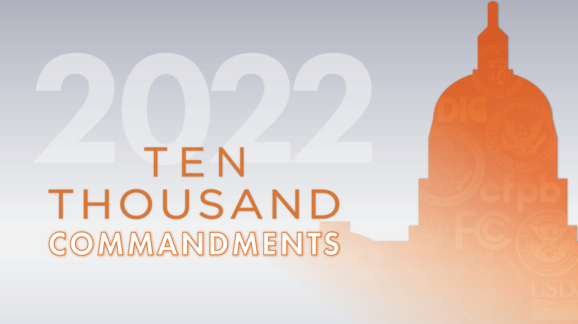Chapter 5: The Presidential Dimension of Regulatory Dark Matter: Executive Orders and Memoranda
Executive orders, presidential memoranda, and other executive actions make up a large component of executive “lawmaking.” They merit attention from lawmakers, since they can have, or appear to have, binding effect and influence private behavior. Executive orders ostensibly deal with the internal workings and operations of the federal government, and presidents have traditionally been presumed able to overturn those issued by their predecessors. Their use is not new, dating back to President George Washington’s administration. Since the nation’s founding, presidents have issued more than 15,582 executive orders (see Table 4). However, their reporting and numbering have not been consistent until recent decades.
Biden’s 77 executive orders in 2021 were the most seen in recent decades. Sixteen issued by Trump in the final weeks of his term in January brought the total for 2021 to 93 (see Figure 16). Trump had issued 68 executive orders in 2020, the highest level in 25 years, outstripping anything since 2001’s high-water mark of 67 (as a transition year, 2001 included 14 Clinton orders and 53 Bush ones). Trump had issued 63 in 2017, 47 in 2019, and 35 in 2018.
Table 5. Executive Orders by Administration

President Obama’s executive order totals, “pen-and-phone” directives notwithstanding, were not high compared with those of other presidents. At the end of his term, Obama had issued 276 executive orders, whereas President George W. Bush’s final tally was 291, while that of President Bill Clinton was 364 (see Table 4 and Figure 16).
Executive memoranda are trickier to tally. They may or may not be published in the Federal Register or other easily accessible sources, depending on each administration’s own determination of “general applicability and legal effect,” and are not numbered the way executive orders are now. There were 31 memoranda in 2021, 26 from Biden and five from Trump.
Recognizing the overlap that occurs in transition years, during the eight calendar years encompassing President George W. Bush’s presidency, 129 memoranda were published in the Federal Register, whereas the Barack Obama years saw 255 issued (Figure 16). Bill Clinton published 84 during his presidency that have been recorded so far. Donald Trump issued 152 during his term. Trump’s 59 memoranda issued in 2020 is the highest single-year count to appear in the Federal Register database, which records totals back to 1994 (2010’s 42 comes in second). But again, some directives issued by Trump were deregulatory in intent. Furthermore, the Federal Register is not a complete compendium of executive actions.
The pertinent question regarding federal intervention is what these executive orders and memoranda are used for and what they do. Whether lengthy or brief, orders and memoranda can have significant effects, and a smaller number of them do not necessarily mean small effects. We find presidents invoking such executive actions if Congress fails to act on their agenda. As with the Federal Register rule counts, the tallies of orders and memoranda are interesting but do not tell the full story. In 2014, Obama administration memoranda (not even among the presidential ones shown here) created a new financial investment instrument, implemented new positive rights regarding work hours, and employment preferences for federal contractors. In contrast, four of Obama’s executive orders addressed overregulation and rollbacks, such as Executive Order 13563 on regulatory review and reform. It amounted to a few billion dollars in cuts, which were swamped by other, newly issued rules and guidance.
While nothing comparable to Trump’s deregulatory agenda was implemented, key executive orders directed at regulatory restraint were President Bill Clinton’s 1993 Executive Order 12866 and President Ronald Reagan’s Executive Order 12291, which formalized central regulatory review at OMB. Clinton’s was a step back from the stronger oversight of the Reagan order in that it sought “to reaffirm the primacy of Federal agencies in the regulatory decision-making process.”
The United States existed for several decades before a president issued more than two dozen executive orders. That was President Franklin Pierce, who served from 1853 to 1857. Orders numbered in the single digits or teens until President Abraham Lincoln and the subsequent Reconstruction period. President Ulysses S. Grant issued 217, then a record. From the 20th century onward, executive orders have numbered over 100 during each presidency and sometimes reached into the thousands. President Franklin D. Roosevelt—the longest-serving president in U.S. history, elected to four terms and having served a full three—issued 3,721 executive orders. Table 4 provides a look at executive order counts by administration since the nation’s founding through the Trump presidency.
In addition to the notices and executive orders that appear in the Federal Register, there are pronouncements on the periphery. As in the Obama years, we see numerous “Fact Sheets,” such as one accompanying the aforementioned Justice Department meat processing directive.
